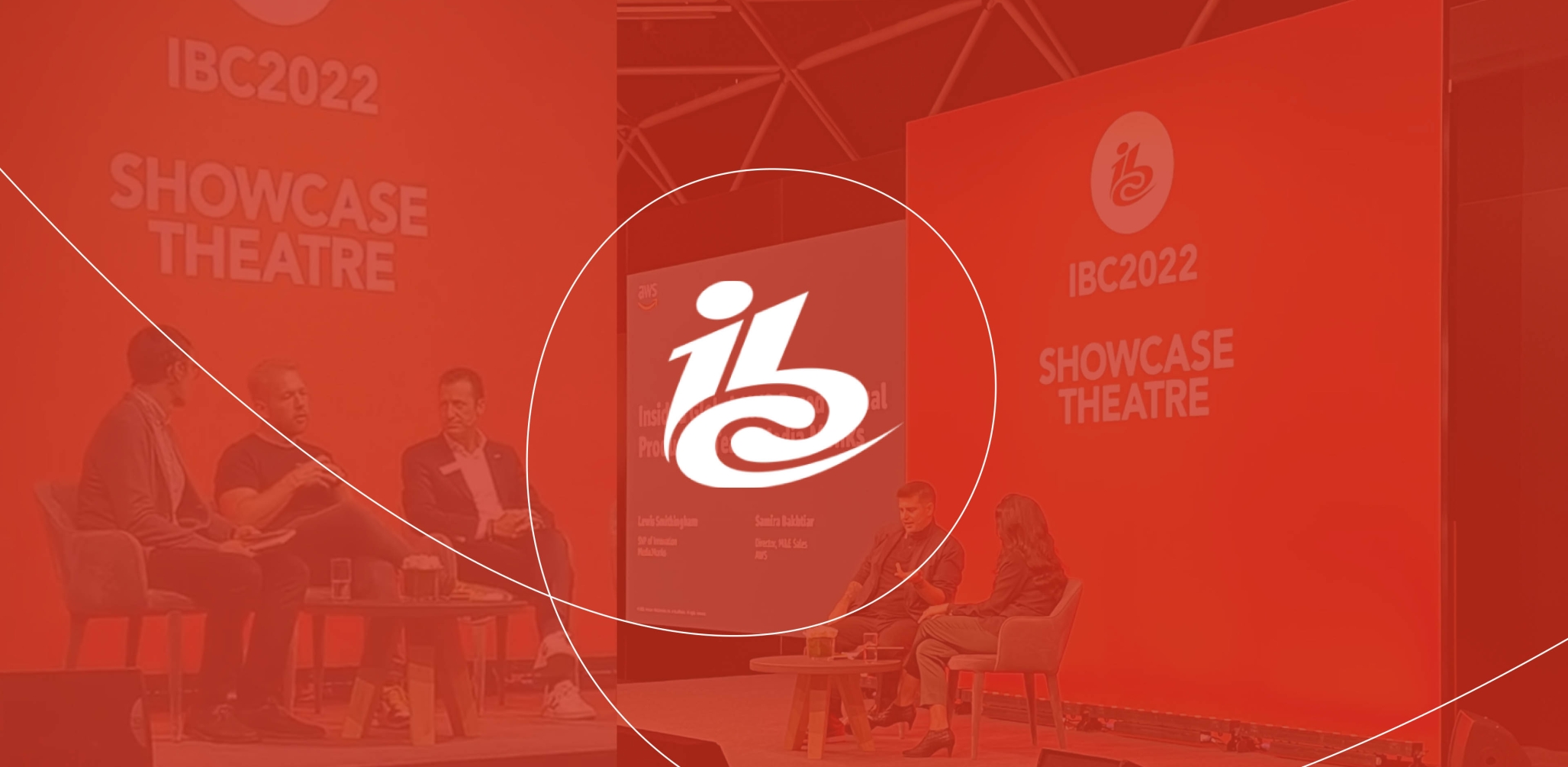IBC Show 2022 Captures Broadcasting for a New Era

September saw the launch of IBC 2022 in Amsterdam, one of the most influential conferences of the broadcasting industry, which made its triumphant return to face-to-face engagement. Naturally, we couldn’t pass up on the opportunity to show up in person.
Many might think that broadcasting is very traditional, loosening its grip on the cultural current as people turn more and more toward immersive, interactive experiences like gaming and the metaverse. But the IBC Show is anything but traditional, and this year our Monks on the ground (and on the stage) explored the broadcasting’s transformation in the virtualized era, from capturing new kinds of content to showing off workstreams that unlock incredible, new storytelling opportunities.
Innovation is at the forefront of the conference. We’re leaning into the future, and IBC is an optimistic part of that future.

If it’s not interactive, it’s broken.
Video killed the radio star—and with the rise of the metaverse and an increasingly digital culture, is TV next on the chopping block? Smithingham opened the second day of the event with a keynote talk, “Step Into the Metaverse,” in which he set the stage for a new era of multi-dimensional, interactive media. The central thesis: traditional, flat media is less relevant today’s Gen Z and Gen Alpha audiences. “A core undercurrent across all of this is if something is not interactive to younger generations, it feels broken and disconnected,” says Smithingham, showing how live sports viewership is down and that most of the discussion surrounding the Super Bowl is about the halftime show instead of the game.
Still, Smithingham doesn’t want to discourage the industry; rather, now is the time for broadcasting players to take an active part in driving culture forward. “Broadcasting is culture. It’s the vehicle by which culture spreads,” he says, making the case by illustrating how text messaging volume directly correlated with American Idol viewership throughout the aughts. Likewise, broadcasting can embrace emerging technologies and behaviors—like livestream commerce—to connect more closely with today’s audiences and tap into new storytelling possibilities. For example, we partnered with Logitech to break out of the exclusive, VIP-focused awards show format with the Song Breaker Awards, making it more accessible and interactive for audiences in the metaverse.
To Rob McNeil, VP of Live at Media.Monks, these immersive experiences will become complimentary to more traditional broadcast experiences. “It will coexist. Certain people will gravitate toward certain kinds of content,” he says, noting how he personally would rather watch sports in VR rather than on a TV. While he sees a future in 180- or 360-degree movies and TV shows, music performances and sports seem to be the use cases that make the most sense right now. “These are natural areas for immersive experiences,” he says, noting how music in particular takes advantage of spatial audio in the Meta Quest 2.
The lesson for brands and broadcasters? Break out of the traditionally one-way conversation of broadcasting and instead create a multidirectional ecosystem: a halo of virtual worlds, social content, streaming content, creator channels, podcasts, audience interaction and more. “It’s about feeding an audience that’s always on,” says Smithingham. “We have to evolve how we tell our stories.” You can learn more insights from Smithingham in the IBC interview below.
Esports points a way forward.
Marketers and broadcasters looking for examples of multidirectional ecosystems can turn to the esports space, which is taking some learnings from traditional sports while also establishing best practices of its own. Esports are a fast-growing industry, with 29.6 million monthly esports viewers this year—an 11.5% increase over 2021, according to Insider Intelligence. Funs Jacobs, our Gaming Category Lead, shared the stage with Nicolas Bourdon, CMO at EVS, and George Pratchett, Production Manager at Promod Esports, to discuss the new frontier of esports as they become increasingly mainstream.
Jacobs notes that most of the revenue earned in esports comes from sponsorships—but the number of esports games per year pale in comparison to, say, your average FIFA league, which amounts to less opportunities for sponsorship overall. That’s why in addition to hosting more games and tournaments, Jacobs encourages competitive gaming developers, leagues and teams to explore fan engagement on new social platforms. In addition, there is a new opportunity to strengthen their communities with blockchain-enabled technologies like NFTs, as brands can now cultivate a sense of ownership with their fans.
Give brands more opportunities to get involved. The viewer numbers are there, and the overall number of people who play video games is 3 billion worldwide.

Teams like FaZe Clan and 100 Thieves have done well to expand beyond tournaments into video content—FaZe Clan has four YouTube channels and 8.66 million subscribers to its main one—apparel, NFT drops, podcasts and dozens of channels run by individual content creators and pro players that have signed onto teams. 100 Thieves is even in the early stages of developing a game of its own.
The variety of digital content offers not only new opportunities for sponsorship and revenue, but also different options for fans and viewers to engage as they see fit. “One thing we can learn from streamers is the level of accessibility,” says Jacobs. “These creators are so accessible despite being so far away in terms of lifestyle and skill level.”
Cloud-based workflows unlock new storytelling opportunities.
Broadcasting of the future requires new ways of working, and Smithingham joined Samira Bakhtiar, Director of Sales, Media & Entertainment at Amazon Web Services (AWS) to give conference attendees an inside look at our global, AWS-based virtual production team. While broadcasts are typically produced by an on-the-ground team tangled in wires and packed in a truck, our cloud-based setup unites personnel who are working across several different locations.
Here's what it looks like. We put together a rack of gear, coders, monitors and uninterruptible power supplies. We then send two or three people to a location who take the rack, power it up and plug it directly into AWS via a network connection. “This is a direct connection outside of the internet, so we’re not susceptible to interferences, says Patrick Jones, Senior Director of Engineering, Live/Broadcast and Creative Solutions at Media.Monks. “We don’t have issues like outages from local ISPs.”
Anywhere from 36 to 40 virtual machines are connected in the cloud, ranging from graphics servers, audio servers, playback servers that enable instant replays, and more. The cloud also connects dozens of people throughout a distributed team. “A director in Florida can collaborate with a tech director in England and audio people in New York,” says Jones. And despite the distance across teams, latency is negligible and just a matter of milliseconds.
There are people all over the place, and that’s the beauty of having a decentralized workflow. Our communications system lets us talk as if we’re right next to each other, which makes things so much simpler.

Still, any live broadcast comes with a series of factors that may present the need for redundancies, whether that be extra equipment or multiple recording backups. “We’re the department of redundancy. It’s what we do: continue to make sure we have multiple systems in place to protect us,” says Jones. He notes that while traditional broadcasting trucks also have redundancies built in, things break, and having two of every piece of equipment isn’t practical. “If you’re in a truck, you may not have the ability to get another computer in. But in the cloud, we can quickly pivot to spin up another system or backup.”
Beyond the added efficiencies in stability and collaboration, one benefit of the AWS-powered workstream shouldn’t go unnoticed: it greatly reduces the carbon footprint of a broadcast, which would traditionally involve flying out an entire fleet of professionals. “We just have three people flying in for a typical production, and everyone else is in the cloud,” says Smithingham.
Broadcasting continues to evolve and innovate.
“Two years ago, we didn’t have some of the tools in the cloud that we have now,” says Jones. After exploring the showroom floor, he applauds the level of innovation at IBC. “Seeing all the people that are innovating, we advanced by maybe three years in six months. The pandemic forced a lot of companies to up their game, and we’re all reaping the benefits of that.”
We showed off our own innovation at the booth for RED Digital Cinema, who is disrupting the film production scene with camera equipment that is more affordably priced than more traditional names. At the booth, we shared a behind-the-scenes look at the making of Post Malone’s Twelve Carat Toothache VR performance, viewable on Meta Quest devices captured on RED’s cameras. Our team built a way to live-stitch the footage to accommodate VR viewing in a 4K resolution, streamed directly to Quest headsets as the footage is captured.
The shooting-to-viewing pipeline is important because advanced imaging isn’t just a learning curve for production crews; it forces performers to engage with the camera in new ways, too. “The camera’s movement is often limited, due to naturally occuring motion sickness,” says McNeil. “For artists, that’s challenging because they have to come toward the camera, rather than have the camera come to them.” Throughout the Twelve Carat Toothache shoot, the crew could let Post Malone inhabit the viewer’s perspective in between performances, influencing his stage presence.
To bring the same experience to the demo booth, we had headsets on hand capturing live footage of the conference floor. “As people create content with technology like this, we become desensitized to it, but people experiencing it for the first time were like, ‘This is simply stunning—absolutely amazing,’” says Jones.
The demo between team Media.Monks and team RED demonstrated more than just the potential of new technology. It also showed a spirit of partnership that permeated much of IBC this year. “You saw a lot of people going from booth to booth—not like an upstart going to the industry giants to get their foot in the door, but rather a lot of established names wanting to work together,” says McNeil.
It used to be separate workflows across the board. Now everyone has their own nuance or expertise and are working together to see what they can do together.

To say that the world has changed since IBC’s last in-person conference in 2019 would be an understatement. But this year’s edition showed how the broadcast itself is in a state of evolution—one that will show no signs of slowing down soon. “We need to virtualize everything from our culture to how we do our work,” says Smithingham. From expanding content across different formats, to learning from emerging industries like esports, to exploring entirely new workflows, IBC 2022 offered several looks into the future of broadcasting—and it’s looking bright.
Related
Thinking
-
![Four people sitting at a panel discussion with banners that read "SoDA Series"]()
Blog Post
Embracing the AI Revolution in Creative Industries: Insights from SoDA Series Live at SXSW By Media.Monks 2 min read -
![Abstract image that features the Media.Monks and NVIDIA GTC logos.]()
Blog Post
Media.Monks Will Be at NVIDIA GTC 2024—Why You Should Go and What There Is to See By Henry Cowling 4 min read -
![Collage of headshots featuring Gavin Stradi, Hoda El Nazer, Nada Nassar, Tomas Almuna and Pierre Nelwan.]()
Blog Post
Looking Forward to Dubai Lynx 2024: What Makes the MENA Region a Goldmine for Creative Opportunities By Pierre Nelwan 6 min read
Make our digital heart beat faster
Get our newsletter with inspiration on the latest trends, projects and much more.
Media.Monks needs the contact information you provide to us to contact you about our products and services. You may unsubscribe from these communications at any time. For information on how to unsubscribe, as well as our privacy practices and commitment to protecting your privacy, please review our Privacy Policy.



